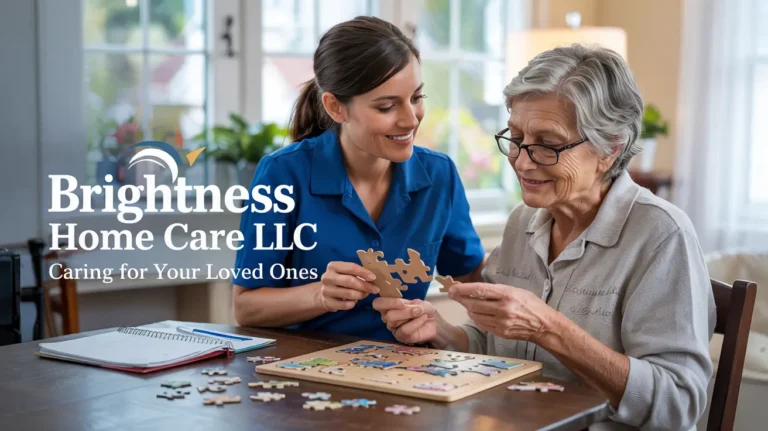Comparing Respite Care Services in Indianapolis: Finding the Right Support for Your Loved One
Did you know that nearly 40% of family caregivers report high levels of emotional stress that can lead to burnout? I didn’t realize how common this was until I found myself completely exhausted after caring for my aunt for just three months! Respite care turned out to be the lifeline I desperately needed, giving me a chance to recharge while ensuring my loved one received quality care.
Respite care is essentially short-term relief for primary caregivers, allowing them to take a much-needed break from their caregiving responsibilities. These breaks aren’t just nice to have—they’re essential for maintaining your own physical and emotional health while providing the best possible care for your loved one.
When I first started looking into respite care options in Indianapolis, I was honestly overwhelmed by all the choices. Each service seemed to offer something different, and I had no idea how to compare them effectively. That’s why taking the time to evaluate and compare different respite care providers is so crucial—your peace of mind and your loved one’s wellbeing depend on finding the right match!
If you’re feeling lost in the sea of options like I was, don’t worry. Brightness Home Care LLC, located at 4911 West 38th Street in Indianapolis, offers specialized respite care services designed to meet your unique needs. But before making any decisions, let’s dive into what you should know about respite care options in our area.
Understanding Respite Care and Its Benefits
When my mother was diagnosed with Parkinson’s, I had no idea what respite care even meant. I thought I could handle everything on my own—boy, was I wrong! Respite care basically gives primary caregivers like me a temporary break while ensuring our loved ones continue receiving professional care. It comes in different flavors—in-home care where professionals come to your house, adult day centers, or short stays at residential facilities.
The benefits are honestly life-changing for everyone involved. For caregivers, it prevents that awful burnout I experienced during my first year caring for Mom. I remember breaking down in tears one day because I couldn’t remember the last time I’d slept more than four hours straight! Respite care gave me a chance to catch up on sleep, attend my own doctor appointments, and even meet friends for coffee—simple things that preserved my sanity.
For the person receiving care, it provides stimulation and socialization with someone new. My mother actually perked up when her respite caregiver visited! They played different card games than I knew and shared stories I’d never heard before. This fresh energy benefited her emotionally and cognitively in ways I couldn’t provide alone.
How do you know when it’s time for respite care? Watch for the warning signs I missed: feeling constantly exhausted, becoming easily irritated, withdrawing from activities you once enjoyed, or neglecting your own health. If you’re snapping at your loved one over minor issues, that’s a major red flag that you need support.
One misconception I had was thinking respite care meant I was somehow failing as a caregiver. That couldn’t be further from the truth! Using respite services actually made me a better caregiver because I returned refreshed and more patient. Another myth I encountered was that my loved one would feel abandoned—in reality, most care recipients enjoy the change of pace and new interactions.
The truth is, respite care isn’t just a luxury—it’s an essential component of sustainable caregiving. Looking back, I wish I’d started using respite services much sooner instead of waiting until I was completely drained.
Top Factors to Consider When Comparing Respite Care Providers in Indianapolis
When I first started calling around to different respite care providers in Indianapolis, I had no clue what questions to ask! After some painful trial and error (and one particularly disastrous experience with an undertrained caregiver), I’ve learned what really matters when comparing services.
Staff qualifications should be at the top of your list. I made the mistake of not asking about training, and we paid the price when a caregiver didn’t know how to properly transfer my father from his wheelchair. Now I always ask: What specific training do your caregivers receive? Are they certified in CPR and first aid? What about specialized training for conditions like dementia or Parkinson’s? The best providers, like Brightness Home Care LLC, have rigorous training programs and ongoing education for their staff.
The range of services offered varies dramatically between providers. Some offer only basic companionship, while others provide personal care, medication reminders, meal preparation, and transportation. I needed someone who could help with Mom’s showering routine and drive her to physical therapy appointments. Make a list of exactly what assistance your loved one requires and confirm the provider can meet those specific needs.
Flexibility became super important to me when my work schedule suddenly changed. Can the provider accommodate last-minute requests? Do they offer overnight care or just daytime hours? Some agencies require minimum visit lengths of 4 hours, which wasn’t always necessary for us. Brightness Home Care LLC impressed me with their willingness to create customized scheduling solutions that actually worked for our family’s changing needs.
Don’t skip checking reviews and asking for references! I wish I’d done this before hiring our first respite caregiver. Talk to other families using their services and ask specific questions about reliability and quality of care. One agency I called had glowing online reviews but seemed oddly reluctant to connect me with current clients—major red flag!
Cost structures can be confusing, with some providers charging hourly and others having daily or half-day rates. Some include transportation costs while others charge extra. Always get a detailed breakdown of all potential charges to avoid surprise bills. I learned this lesson the hard way after receiving an unexpected invoice for “mileage fees” that nobody had mentioned.
Finally, check whether the provider accepts long-term care insurance, VA benefits, or Medicaid waivers if applicable. This can significantly reduce out-of-pocket costs. Some agencies only accept private pay, which might limit your options depending on your financial situation.
Evaluating In-Home Respite Care vs. Facility-Based Options
Choosing between in-home and facility-based respite care was one of the toughest decisions our family faced. There are real advantages and drawbacks to each option that I discovered through personal experience.
With in-home respite care, your loved one stays in familiar surroundings, which was huge for my dad who got anxious in new environments. The care is completely one-on-one, so your family member receives undivided attention. I loved that we could maintain Dad’s exact routine and preferences—like his specific bedtime ritual that helped prevent nighttime confusion. Plus, there’s minimal exposure to illnesses that can spread in group settings, which was especially important during cold and flu season.
However, in-home care typically costs more per hour than facility options. We also had to be comfortable with someone coming into our home, and the first caregiver wasn’t a great personality match for Dad (though we eventually found someone wonderful through Brightness Home Care LLC). In-home care also doesn’t provide the same level of socialization with peers.
Facility-based respite care, on the other hand, offers built-in social activities and interactions with other seniors. Many have specialized equipment that might not be available in your home, like therapeutic baths or activity rooms. When Mom attended a weekend respite program at a local facility, she actually enjoyed the change of scenery and came back telling stories about the people she’d met.
The downside? The unfamiliar environment can be disorienting, especially for people with cognitive impairments. There’s less personalized attention since staff care for multiple people. And some facilities have minimum stay requirements of several days, which was more than we needed initially.
Determining which type is best really depends on your loved one’s personality and care needs. My father, who had early-stage Alzheimer’s, became extremely agitated in unfamiliar settings, so in-home care was clearly better for him. But my mother, who was more socially oriented, actually preferred occasional weekends at a respite facility where she could participate in group activities.
If you’re unsure which would work better, try starting with shorter in-home visits to build trust in the respite care process. Many families, including mine, eventually use a combination of both types—in-home care for regular weekly breaks and facility care for when longer coverage is needed, like during a family wedding weekend or when I needed minor surgery and couldn’t provide care for several days.
Spotlight on Brightness Home Care LLC’s Respite Services
When I finally connected with Brightness Home Care LLC on West 38th Street, I immediately noticed the difference in their approach to respite care. Instead of the one-size-fits-all program I’d encountered elsewhere, they took the time to understand our specific situation. The initial assessment was so thorough—they asked questions about Dad’s preferences and routines that hadn’t even occurred to me, like what time of day he typically had the most energy and which topics of conversation he enjoyed.
Their caregivers aren’t just experienced—they’re specifically matched to your loved one’s needs and personality. I was impressed to learn that their respite care staff receive specialized training beyond basic certifications, including courses in dementia care, fall prevention, and communication techniques for seniors with hearing impairments. When Dad’s memory started declining, his caregiver already knew exactly how to redirect conversations without causing frustration—a skill I was still struggling to master.
What really sets Brightness Home Care apart is their flexibility. Unlike some agencies that required us to book weeks in advance, they were able to accommodate relatively short-notice requests when my sister’s health crisis meant I needed extra coverage unexpectedly. Their respite care isn’t just about basic supervision either—their services include medication reminders, meal preparation, light housekeeping, transportation to appointments, and engaging activities tailored to your loved one’s interests and abilities.
They serve families throughout Indianapolis, with particular expertise in the west Indianapolis area. Their proximity to our home meant caregivers could reach us quickly even during bad weather, which proved invaluable during last winter’s ice storm when I couldn’t safely drive to Dad’s house.
The scheduling options impressed me too. Whether you need regular weekly breaks, occasional weekend coverage, or emergency assistance, they work with you to create a sustainable plan. I started with just four hours twice a week, but during particularly stressful periods at work, I was able to temporarily increase that without any hassle. They even offer overnight respite care, which gave me my first full night’s sleep in months when I was recovering from bronchitis!
Cost Comparison for Respite Care in Indianapolis
Let’s talk about the elephant in the room—cost. When I first started researching respite care options in Indianapolis, the price variations confused me completely! After comparing multiple providers, I found that hourly rates for in-home respite care typically range from $20 to $35 per hour, depending on the level of care needed and the agency’s fee structure.
Facility-based respite care generally charges daily rates instead, usually between $150 and $300 per day for overnight stays. Adult day centers, which provide respite during daytime hours only, average $65 to $100 per day. It’s worth noting that specialized care for conditions like advanced dementia typically falls at the higher end of these ranges.
The difference between hourly and daily rates tripped me up at first. If you need just a few hours of care, hourly services are usually more economical. But once you cross that 8-hour threshold, daily rates at facilities often become more cost-effective. I made a spreadsheet to compare the total weekly cost based on our specific needs, which really helped clarify the financial picture.
Don’t be afraid to ask about potential funding sources! I had no idea my dad’s long-term care insurance policy included respite benefits until a helpful case manager at Brightness Home Care LLC suggested I check. Other potential financial assistance includes Veterans Affairs benefits for qualified veterans and their spouses, Medicaid Home and Community-Based Services waivers (though there’s often a waiting list), and grants from non-profit organizations like the Alzheimer’s Association.
Looking beyond just the hourly rate was a lesson I learned the hard way. Some agencies charged less per hour but required minimum visits of 4 hours, while others charged more but would come for just the 90 minutes I needed to attend my therapy appointment. Some included transportation in their rate, while others charged extra for driving my mom to her doctor appointments.
Brightness Home Care LLC offers competitive pricing within the Indianapolis market, and I appreciated their transparency. They provided a clear breakdown of all potential costs upfront and even helped me calculate approximately how much we’d spend monthly based on our care plan. They were also willing to work with our long-term care insurance provider directly, handling most of the paperwork nightmare I’d experienced with previous agencies.
Remember that the cheapest option isn’t always the best value. When we tried a bargain-rate agency, the caregiver spent most of her time on her phone instead of engaging with Dad. The slightly higher rate at Brightness Home Care ultimately delivered much better quality care and actual peace of mind—and that’s worth every penny.
Creating a Successful Respite Care Plan
Jumping into respite care without a proper plan is like trying to bake without a recipe—trust me, I learned this lesson the hard way! When we first started with respite care, I gave minimal instructions and then wondered why things didn’t go smoothly. Now I know better.
The first step is honestly assessing your loved one’s specific needs. I created a detailed care plan listing Dad’s typical daily schedule, medications, dietary restrictions, favorite activities, and potential challenges a caregiver might face. I included notes about his preference for showering in the evening rather than morning and how he gets anxious if the TV news is on. These details might seem minor, but they make a huge difference in your loved one’s comfort level with a new caregiver.
Preparing both yourself and your care recipient is crucial for success. I started by introducing the concept of respite care gradually, explaining to Dad that I needed some help and this person would be a new friend coming to spend time with him. For someone with dementia, you might frame it differently—perhaps as a visitor or companion rather than a caregiver. I also prepared myself by acknowledging my own feelings of guilt (which were intense at first!) and reminding myself that taking breaks would make me a better caregiver overall.
Communication with your respite provider can make or break the experience. I keep a notebook where caregivers can leave notes about how the visit went, and I do the same when I notice changes in Dad’s condition or routine. This ensures important information doesn’t fall through the cracks. Don’t be shy about giving specific instructions—I felt awkward at first being so detailed, but good caregivers actually appreciate knowing exactly what works best for your loved one.
Building a long-term strategy has been essential for sustainability. Rather than waiting until I’m completely burned out, I now schedule regular respite breaks as preventative maintenance for my own wellbeing. We started with just a few hours weekly and gradually built up to a consistent schedule that includes one overnight break monthly, which gives me time to properly recharge.
Transitioning between primary and respite caregivers went more smoothly once I started overlapping our time for the first 15-30 minutes. This allows for a proper handoff and helps my father feel more secure seeing us together before I leave. I also created a “welcome book” with photos and names of family members, favorite topics of conversation, and personal history that helps new caregivers connect with Dad more quickly.
Don’t get discouraged if the first respite experience isn’t perfect! Our first attempt was honestly a bit rocky—Dad was confused and the caregiver didn’t follow his routine. Instead of giving up, we adjusted our approach, provided more detailed instructions, and tried again. Now respite care is a natural, beneficial part of our caregiving arrangement that works for everyone involved.
Conclusion
After diving deep into the world of respite care options in Indianapolis, I’ve learned that taking the time to compare services isn’t just helpful—it’s absolutely essential for finding the right support system for both you and your loved one. The right respite care partnership can transform your caregiving journey from overwhelming to sustainable.
Remember those key factors we discussed—staff qualifications, service range, flexibility, reviews, and cost structures. Each of these elements plays a crucial role in determining which provider will best meet your specific needs. There’s no one-size-fits-all solution when it comes to respite care, which is why thoughtful comparison is so important.
If you’re feeling overwhelmed by the options or unsure where to start, reach out to Brightness Home Care LLC at their West 38th Street location in Indianapolis. Their team understands the unique challenges caregivers face and can provide personalized guidance based on your situation. I wish I’d connected with them months before I did—it would have saved me so much stress and trial-and-error!
Taking care of yourself isn’t selfish—it’s actually an essential part of being a good caregiver. The airplane oxygen mask analogy really is true: you need to secure your own wellbeing first to effectively care for others. Respite care isn’t about giving up responsibility; it’s about ensuring you have the physical and emotional resources to provide the best possible care over the long term.
Why not take that first step today? Schedule a consultation with Brightness Home Care LLC to discuss your respite care needs and discover how their personalized approach could make all the difference for your family. Your future self—rested, more patient, and emotionally replenished—will thank you!







